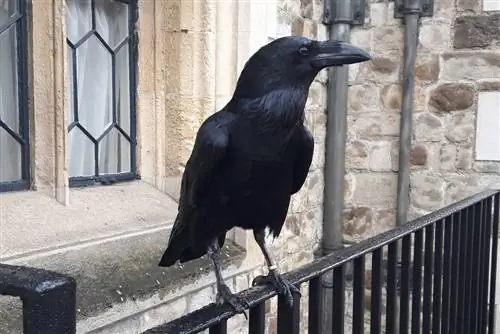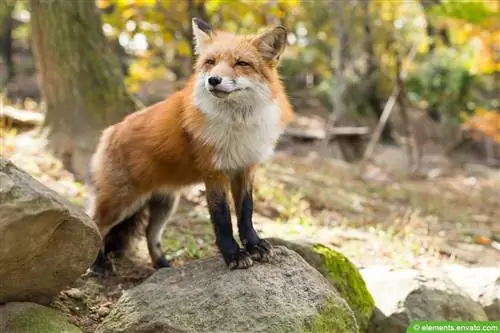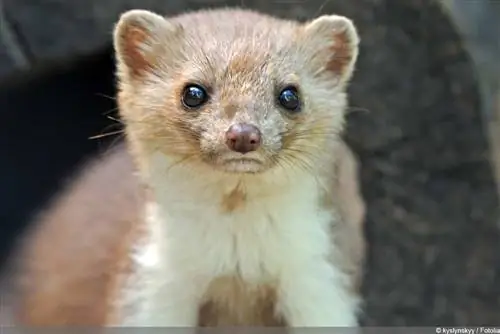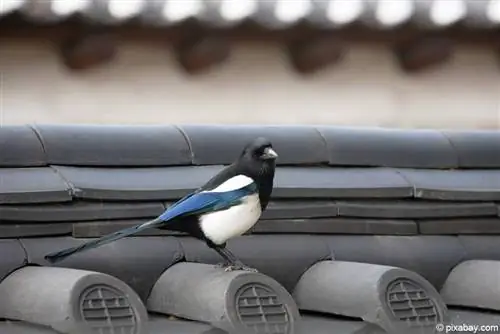- Author admin [email protected].
- Public 2023-12-17 03:39.
- Last modified 2025-06-01 06:48.
Once ravens and crows have settled in the garden and the surrounding area, this shows that this new home offers the large birds many advantages. This needs to be stopped so that the annoying animals, which are a problem for local songbirds in particular, can be driven away again. This can be difficult because the intelligent animals have little fear.
Ravens and crows - resourceful and intelligent
Ravens and crows are large and clever birds. Thanks to their intelligence and great ingenuity, they can quickly outsmart those around them. Because they quickly acquire new skills, especially in order to get food. They can also make tools from leaves and twigs. They also open doors or lids if they suspect food. But it is precisely this intelligence that makes it difficult for us humans to drive birds out of our garden. You also have to pay attention to the following when the birds settle in your own garden:
- not just one crow is coming
- the birds live in families
- so we can expect more animals
- look for an attractive environment for nesting
- this includes open trash cans
- Garbage bags
- open compost
- Fruits, fruit trees or vegetables
- Feeding places for songbirds
- Nesting boxes with nests of songbirds
Creating unattractive surroundings
Ravens and crows like to settle where they can find food and nesting places. Therefore, the environment in the garden must be made as unattractive as possible for them. Above all, this includes protecting all food sources for the ravens and crows as best as possible. If you keep your household waste in bags in front of your yard door, you shouldn't be surprised if ravens and crows quickly settle there. Because destroying the plastic bags to get to the food stored in them is easy for the intelligent birds. The following measures can help, even if the birds have already settled in the garden:
- Never overfill trash cans
- Lid must close easily
- Anchor handles in the ground with rods
- otherwise small garbage cans will be thrown over
- Always cover compost
- especially when leftovers from the kitchen end up here
- Protect garden beds, fruit trees and bushes with net
- Crows eat caterpillars and insects
- but don't disdain the vegetables grown
- cherry trees or berries are particularly preferred
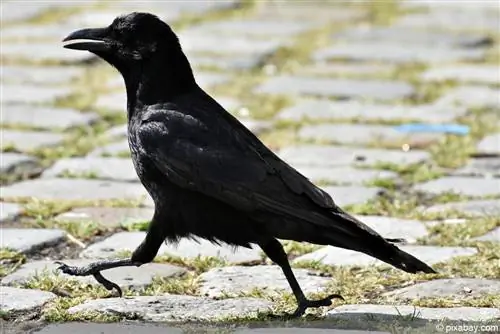
So that the harvest is not endangered in summer, trees, bushes and the garden bed should be protected with nets with a hole circumference of no more than 10 cm in diameter. Although songbirds can still get to the insects, the corvids have no way of getting to berries and cherries.
Change feeding places
The local songbirds should be fed, especially in winter, especially when it is very cold and the birds cannot find food in the snow-covered areas. But these feeding places in particular are very attractive for ravens and crows. If the corvids appear in the area, the feeding places should be avoided. But there are already feeders that are not suitable for large birds:
- well suited, a self-closing bird feeder
- this closes when large birds land
- is available in well-stocked garden shops
- otherwise only use bird feeders with small openings
- remove spilled food regularly
- this attracts the crows and ravens
Tip:
Ravens and crows don't make much difference to your food. They eat whatever leftover food they can find. This also includes garden waste such as fallen fruit or vegetable scraps, dry bread and much more.
Protect nesting places for songbirds
The nesting places for songbirds in the garden should be well protected from corvids. Because the little chicks of the small birds are at risk. If a crow finds a nest with chicks and gets to them through the hole in the nesting box, they will be eaten. The fatal thing about this is that the corvids remember this feeding place and come back every year. Therefore, only hang up nesting boxes that have a particularly small loophole that must not be larger than 20 cm. Otherwise these nesting boxes should look like this:
- from the entry hole to the inside of the floor there should be at least 15 cm depth
- Remove the bar or bar in front of the hole
- the songbirds do not need these for their approach
- However, crows wait here until a chick looks out of the hole
Remove areas for nesting
The environment can also be made safer from nesting corvids and therefore unattractive by removing their own nesting areas. If the crows don't find a suitable place for their own nest, they usually move on. Crows have a habit of exploring the surrounding area in large numbers. They do this by sitting on branches, roofs or fences. So that you don't find a suitable landing place here, you should proceed as follows:
- removing dead branches from trees
- the leafless branches are a good vantage point for ravens
- Attach bird deterrent spikes to fences or roof edges
- are available in well-stocked stores
- Birds cannot find a place to land on
- Use clear commercial bird repellent gel
- this is spread on branches favored by ravens
- the sticky gel is unpleasant for the birds
- Does not disturb the appearance of the trees due to the transparency
- Turn off outside lights at night, ravens like it bright
Tip:
Especially when the garden is well lit at night, crows and ravens fly to it, who like it bright. The birds like to gather in particularly well-lit places at night.
Take action against crows in early winter
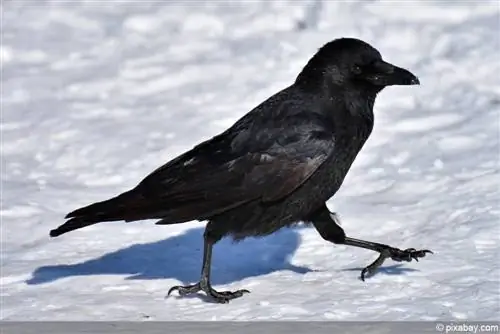
Action should not be taken against the birds until the crows start looking for a suitable nesting place in spring. The problem with the ravens starts much earlier. It is therefore important to tackle the crow problem in your own garden at the beginning of winter. Since these animals are migratory birds, they choose their area at the beginning of winter where they can rest. If they are not disturbed, the ravens could stay all winter and look for a nesting place in the garden in the spring. The following disturbances are useful for driving away crows in winter:
- always drive away in the evening
- so the crows don't stay all night
- make a safe place for the night
- loud noises help with this
- Water from the hose
- turn off all outdoor lights
Deterrent measures
No matter what time of year, there are scaring methods that should always be used to prevent ravens and crows from settling in the garden. At Halloween there are often joke items that include fake crows. These are hung upside down in the trees or under the eaves with their wings spread. The corvids will avoid the environment with supposedly dead members of their species. With dummy birds or fake snakes that are just sat down or laid down, the intelligent animals quickly notice that they are not real and are no longer bothered by them. Other means of expulsion are as follows:
- Corvids are afraid of shiny, moving objects
- special adhesive tape that reflects light is commercially available
- the location of the bands should be changed again and again
- Ravens are very instructive and quickly realize that the light does not harm them
- old CDs can have the same effect
- everything else that shines well and far away
- also an aluminum cake pan or simply aluminum foil
Tip:
The tip is often given to aim a laser beam at the flying animals and thus unsettle them. But this tip is not very recommended due to safety in air or road traffic. In addition, the birds quickly come back when the laser is switched off.
Loud noises
Recurring loud noises can also scare the ravens away. Because if they can't find peace, they'll look for another place. But loud noises in particular should be avoided in the city and are actually only suitable for a secluded property where there are no direct neighbors that could be disturbed. In addition, the loud noises will also disturb the residents of the house itself. The sounds can be generated as follows:
- whenever crows or ravens are in sight
- Play distress calls from crows
- Sounds of enemies of ravens and crows
- this includes hawks or owls
- Exterminators make these noises available online
- loud banging or alarm on tape
- Air Horns

Firecrackers or New Year's Eve firecrackers, however, should beavoided, as these may only be fired on New Year's Eve and not without a specially obtainedpermit. When it comes to the noises, you should also consider that not only ravens and crows could be disturbed by them, but also songbirds or small animals in the garden. Even pets such as dogs or cats don't like many noises, they are afraid and frightened and, in the worst case, could get lost.
Tip:
If the neighborhood gets along well, then they can come together and drive away the crows and ravens from the surrounding area with noises. These measures can then also be applied in a more populated area in a community.
Getting a pet
If dogs or cats move freely in the garden, they can also be very effective at keeping ravens and crows away. These pets have a natural hunting instinct and dogs in particular can keep birds away from the property by barking loudly as soon as they see a crow or raven. Unfortunately, it is also the case that the neighbors could feel disturbed by the barking.

